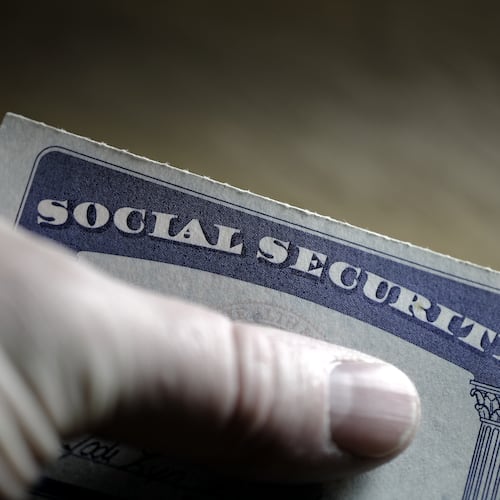House Speaker Nancy Pelosi and U.S. Rep. Jamie Raskin of Maryland announced legislation Friday morning that would allow Congress to remove Donald Trump or any future president from office through the 25th Amendment.
Watch the replay of Pelosi’s news conference:
Pelosi and Raskin said the commission will “enable Congress to help ensure effective and uninterrupted leadership” in the federal government’s executive branch.
The Commission on Presidential Capacity to Discharge the Powers and Duties of Office is linked to the constitution’s 25th Amendment, which outlines the presidential line of succession, or who becomes president should the president become disabled, resign or be removed from office.
Pelosi said the bill to evaluate mental and physical capacity of future presidents is not about Trump, who she said will “face judgment of the voters.” But “he shows the need for us to create a process for future presidents.
“This is not about the upcoming election at all,” Pelosi said, adding “we have to give some comfort to people.” Pelosi said Democrats are not invoking the 25th Amendment against Trump.
Later Friday morning, Trump himself speculated the move is aimed at his Democratic reelection opponent, Joe Biden, in the event Biden should win the White House in less than a month:
The proposed commission, which is unlikely to be approved by the GOP-controlled Senate, would be comprised of 16 members, eight of whom would be chosen by Republicans and Democrats from the medical profession, and eight others from among the ranks of former executive branch officials.
“This would be a truly bipartisan commission,” Raskin said, adding the coronavirus pandemic has shown the need for a succession plan should a president be incapacitated.
“In times of chaos, we must hold fast to our Constitution,” Raskin, who sits on the House Judiciary, Rules and Oversight and Government Reform committees, said. “The 25th Amendment is all about the stability of the presidency and the continuity of the office.”
The White House took immediately to Twitter to denounce the legislation.
In an open letter to House Democrats on Thursday, Pelosi said “the President does not have the capacity, leadership or plan for testing, tracing, and isolation that is needed. Instead, [Donald] Trump’s delay, denial, distortion of reality and disdain for science has exacted a deadly and preventable human toll.”
During a Thursday afternoon briefing, Pelosi told reporters to come back to Capitol Hill on Friday, saying, “we’re going to be talking about the 25th Amendment.” She did not elaborate on her comment.
Trump took to Twitter himself Thursday afternoon after Pelosi’s comment.
Trump will conduct his first person-to-person interview since his coronavirus treatment on Fox News Friday night at 8 p.m. EDT on “Tucker Carlson Tonight.”
The president has not been seen in public, other than in White House-produced videos, since his Monday return from Walter Reed Medical Center where he received experimental treatments for the virus.
On Thursday, his physician, Navy Cmdr. Sean Conley, said in a memo that Trump would be able to safely “return to public engagements” on Saturday, as the president tries to shift his focus to the election that’s less than four weeks away, with millions of Americans already casting ballots.
While Trump said he believes he’s no longer contagious, concerns about infection appeared to scuttle plans for next week’s presidential debate.
“I’m feeling good. Really good. I think perfect,” Trump said during a telephone interview with Fox Business, his first since he was released from a three-day hospital stay Monday. “I think I’m better to the point where I’d love to do a rally tonight,” Trump said. He added, “I don’t think I’m contagious at all.”
The Centers for Disease Control and Prevention says individuals can discontinue isolation 10 days after the onset of symptoms, which for Trump was Oct. 1, according to his doctors. Conley said that meant Trump, who has been surrounded by minimal staffing as he works out of the White House residence and the Oval Office, could return to holding events on Saturday.
He added that Trump was showing no evidence of his illness progressing or adverse reactions to the aggressive course of therapy prescribed by his doctors.
Trump’s campaign and the White House were already drawing up plans for Trump to resume campaigning, eyeing a visit to Pennsylvania on Monday and Michigan on Tuesday ahead of what was to have been next Thursday’s debate.
But the Commission on Presidential Debates announced that event would be held “virtually” in order to “protect the health and safety of all involved.” Trump swiftly rejected that offer, and his campaign later called on the commission to delay the final two debates by a week to alleviate concerns about an in-person contest.
On Thursday, Trump continued to credit an experimental drug for the seemingly quick pace of his recovery. He called his diagnosis a “blessing in disguise” in the nation’s battle against the pandemic.
The 25th Amendment was passed by Congress on July 6, 1965, less than two years after the assassination of President John F. Kennedy. It was ratified on Feb. 10, 1967, and outlines the presidential line of succession, or who becomes president should the president become disabled, resign or be removed from office.
Here’s what the amendment says:
- Section 1. In case of the removal of the President from office or of his death or resignation, the Vice President shall become President.
- Section 2. Whenever there is a vacancy in the office of the Vice President, the President shall nominate a Vice President who shall take office upon confirmation by a majority vote of both Houses of Congress.
- Section 3. Whenever the President transmits to the President pro tempore of the Senate and the Speaker of the House of Representatives his written declaration that he is unable to discharge the powers and duties of his office, and until he transmits to them a written declaration to the contrary, such powers and duties shall be discharged by the Vice President as Acting President.
- Section 4. Whenever the Vice President and a majority of either the principal officers of the executive departments or of such other body as Congress may by law provide, transmit to the President pro tempore of the Senate and the Speaker of the House of Representatives their written declaration that the President is unable to discharge the powers and duties of his office, the Vice President shall immediately assume the powers and duties of the office as Acting President. Thereafter, when the President transmits to the President pro tempore of the Senate and the Speaker of the House of Representatives his written declaration that no inability exists, he shall resume the powers and duties of his office unless the Vice President and a majority of either the principal officers of the executive department or of such other body as Congress may by law provide, transmit within four days to the President pro tempore of the Senate and the Speaker of the House of Representatives their written declaration that the President is unable to discharge the powers and duties of his office. Thereupon Congress shall decide the issue, assembling within forty-eight hours for that purpose if not in session. If the Congress, within twenty-one days after receipt of the latter written declaration, or, if Congress is not in session, within twenty-one days after Congress is required to assemble, determines by two-thirds vote of both Houses that the President is unable to discharge the powers and duties of his office, the Vice President shall continue to discharge the same as Acting President; otherwise, the President shall resume the powers and duties of his office.
According to the Legal Information Institute at Cornell Law School, the 25th Amendment was an effort to resolve the question of what would happen if the president died, resigned, was removed from office or became so incapacitated that he couldn’t fulfill his duties.
Here’s the line of succession for the presidency of the United States:
1. Vice President Mike Pence
2. Speaker of the House of Representatives Nancy Pelosi
3. President pro tempore of the Senate Chuck Grassley
4. Secretary of State Mike Pompeo
5. Secretary of the Treasury Steven Mnuchin
6. Secretary of Defense Mark Esper
7. Attorney General William Barr
8. Secretary of the Interior David Bernhardt
9. Secretary of Agriculture Sonny Perdue
10. Secretary of Commerce Wilbur Ross
11. Secretary of Labor Eugene Scalia
12. Secretary of Health and Human Services Alex Azar
13. Secretary of Housing and Urban Development Ben Carson
14. Secretary of Transportation Elaine Choa, who is not a natural-born U.S. citizen and cannot become president.
15. Secretary of Energy Dan Brouillette
16. Secretary of Education Betsy DeVos
17. Secretary of Veterans Affairs Robert Wilkie
About the Author
The Latest
Featured



